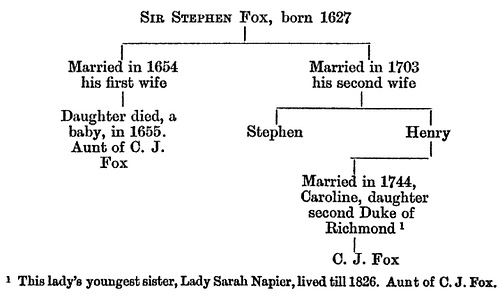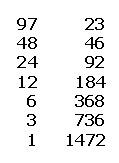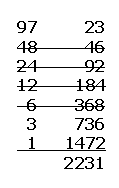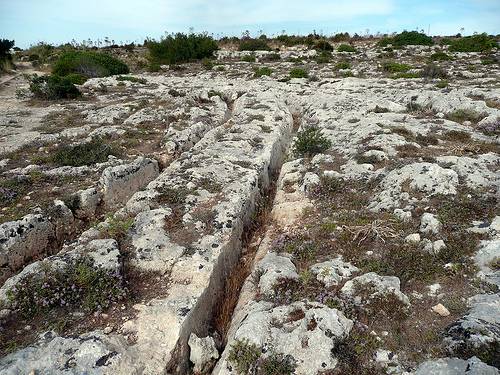DEAD-ENDEDNESSES contains one A, two Ns, three Ss, four Ds, and five Es.
TEMPERAMENTALLY can be separated into a single letter followed by words of 2, 3, 4, and 5 letters: T, EM, PER, AMEN, TALLY.
DEAD-ENDEDNESSES contains one A, two Ns, three Ss, four Ds, and five Es.
TEMPERAMENTALLY can be separated into a single letter followed by words of 2, 3, 4, and 5 letters: T, EM, PER, AMEN, TALLY.
British statesman Charles James Fox managed to have two aunts who died 171 years apart:

Fox’s grandfather married twice — once at 27 and once at 76. A baby produced by the first marriage died in 1655, and a son produced by the second marriage married a woman whose sister died in 1826.
Fox himself died in 1806, but his widow survived until 1842 — nearly 200 years after the death of her aunt-by-marriage.
Here’s a curious way to multiply two numbers. Suppose we want to multiply 97 by 23. Write each at the head of a column. Now halve the first number successively, discarding remainders, until you reach 1, and double the second number correspondingly in its own column:

Cross out each row that has an even number in the left column, and add the numbers that remain in the second column:

That gives the right answer (97 × 23 = 2231). Why does it work?

Malta is criss-crossed with ruts like these. No one knows who made them, when, or why. If they’re cart ruts, why are some 60 centimeters deep? If it’s an irrigation system or some kind of astronomical undertaking, what was its purpose?
The most popular theory is that ancient sledges hauled limestone to build local temples. But why then do some ruts lead straight into the sea?
One summer evening, as I was walking in the fields, I heard somebody behind me calling out my name. I turned round, and saw a friend of mine, at the distance of 400 yards, approaching to join me. We each of us moved 200 yards, with our faces towards the other, in a direct line yet we were still 400 yards asunder. How could this be?
— The Nic-Nac; or, Oracle of Knowledge, Sept. 13, 1823
This is rather amazing. Arrange a deck of cards in this order, top to bottom:
A♣, 8♥, 5♠, 4♦, J♣, 2♥, 9♠, 3♦, 7♣, Q♥, K♠, 6♦, 10♣,
A♥, 8♠, 5♦, 4♣, J♥, 2♠, 9♦, 3♣, 7♥, Q♠, K♦, 6♣, 10♥,
A♠, 8♦, 5♣, 4♥, J♠, 2♦, 9♣, 3♥, 7♠, Q♦, K♣, 6♥, 10♠,
A♦, 8♣, 5♥, 4♠, J♦, 2♣, 9♥, 3♠, 7♦, Q♣, K♥, 6♠, 10♦
Now:
Despite all this, you’ll find that the resulting deck is made up of 13 successive quartets of four suits–and four consecutive straights, ace through king.
The reasons for this are fairly complex, so I’ll just call it magic. You’ll find a full analysis in Julian Havil’s Impossible? Surprising Solutions to Counterintuitive Conundrums (2008).
gruntle
v. to put in a good humor
Commandant Louis Joseph Lahure has a singular distinction in military history — he defeated a navy on horseback.
Occupying Holland in January 1795, the French continental army learned that the mighty Dutch navy had been frozen into the ice around Texel Island. So Lahure and 128 men simply rode up to it and demanded surrender. No shots were fired.

A he-toad loved a she-toad
That lived high in a tree.
She was a two-toed tree toad
But a three-toed toad was he.
The three-toed tree toad tried to win
The she-toad’s nuptial nod,
For the three-toed tree toad loved the road
The two-toed tree toad trod.
Hard as the three-toed tree toad tried,
He could not reach her limb.
From her tree-toad bower, with her V-toe power
The she-toad vetoed him.
— Anonymous
A marble-cutter, inscribing the words,–‘Lord, she was thine’ upon a tombstone, found that he had not figured his spaces correctly and he reached the end of the stone one letter short. The epitaph therefore read:
‘Lord, she was thin.’
— Frederic William Unger, Epitaphs, 1904